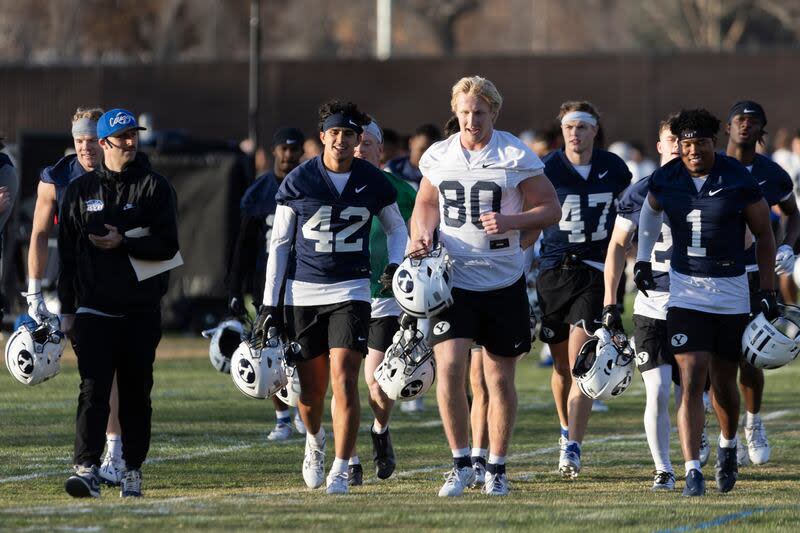What went wrong with BYU’s offense last year, and how can the Cougars fix it?
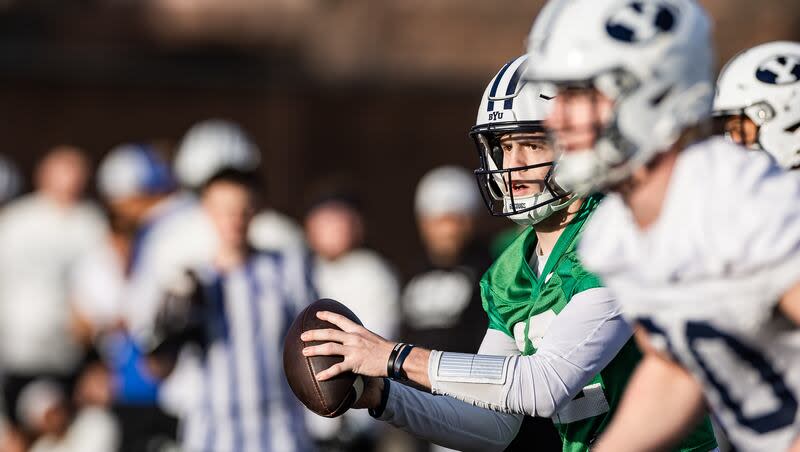
It has been a long and trying football offseason for BYU offensive coordinator Aaron Roderick, the man most responsible for getting the Cougars’ attack rolling again after BYU’s offense plummeted to the bottom fourth of most NCAA statistical categories in 2023.
BYU’s defense, though riddled by injuries, generally improved under the direction of new defensive coordinator Jay Hill — aside from some miserable performances against West Virginia and Iowa State — but the offense definitely took a step backwards from Roderick’s first few years at the helm, and the result was a 5-7 overall record, 2-7 in the Big 12. Two veteran offensive coaches were let go: tight ends coach Steve Clark and offensive line coach Darrell Funk.
“Obviously I was super disappointed in how we played,” Roderick told the Deseret News last month before spring practices began. “We had great continuity on offense in the prior few years at receiver, tight end, quarterback, offensive line. And then a year ago I really underestimated how long it would take for us to play as a unit when we had so many new players.”
New faces included quarterbacks Kedon Slovis and Jake Retzlaff, running backs Aidan Robbins, Deion Smith and LJ Martin, and receivers Darius Lassiter and Keelan Marion and offensive linemen Paul Maile, Weylin Lapuaho and Caleb Etienne. Slovis’ injury in the 35-6 loss to Texas in Game 8 proved to be season-ending, and obviously contributed to the offense’s late-season struggles. But even before then it was sputtering and not up to Roderick’s standards.
“It took us too long to gel and play as a unit, and execute as a unit,” Roderick said. “It started to come together in the last couple games of the year, and even though we didn’t win those games, in the Oklahoma and Oklahoma State games you started to see some rhythm and some tempo and some playmaking. I think we can build on that.”
With the junior college transfer Retzlaff taking over the last four games and Robbins getting healthy after an early-season rib issue, the offense put up 390 yards in the 31-24 home loss to Oklahoma and 327 yards in the season-finale at OSU, a 40-34 loss in double overtime in rainy Stillwater.
The Cougars rushed for 217 yards against OU and 130 against the Big 12 championship game-bound Pokes. Roderick said reestablishing a run game is his No. 1 priority for the 2024 season.
Left out of a bowl game for the first time since 2017, BYU finished No. 99 in the country in scoring offense (23.1 ppg.) and No. 118 in total offense (309.8 yards per game) among 130 Football Bowl Subdivision teams.
They were No. 118 in rushing offense (104.3 ypg) and No. 90 in passing offense (205.4 ypg.).
“That is what I am excited about this year, is so many returning players at every position. Almost everybody is back. We lost Aidan and Kingsley (Suamataia), but we have a good bit of experience I guess you could say from last year,” Roderick said. “We got our noses bloodied a little bit, but everybody is coming back and knows what we are in for.”
Continuity matters
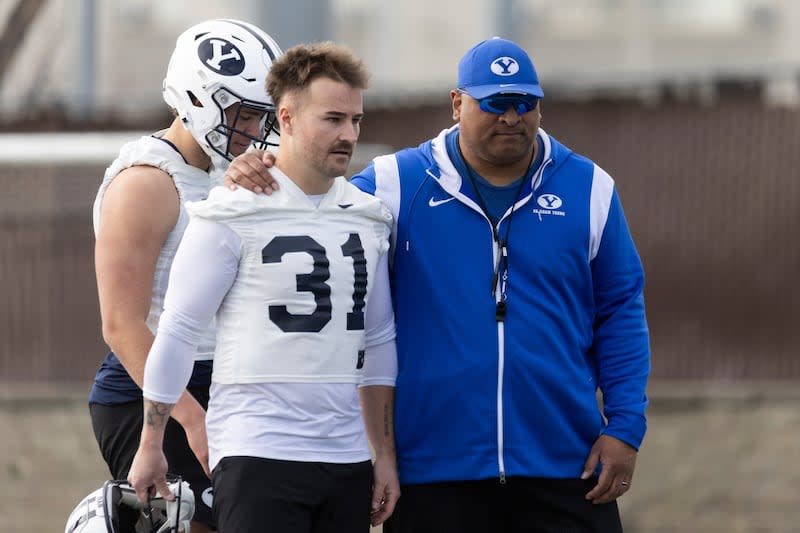
If the surprising success of the BYU men’s basketball team in its first season in the powerful and loaded Big 12 has proven anything, it is that roster continuity and “growing old together,” as coach Mark Pope puts it, matters a lot in college sports. The Cougar hoopsters, with only a few additions to the squad that went 19-15 last season, are ranked No. 20 in the AP Top 25 poll and had a 9-7 league record, 21-8 overall, heading into Wednesday’s showdown at No. 6 Iowa State.
“That’s a good example,” Roderick said. “I believe in that continuity, that consistency. That situation with the basketball team is a great lesson.”
Roderick said scoring in college football has gone down three seasons in a row, which roughly mirrors the surge in transfers. The game clock was not stopped last year after first downs until the final two minutes of each half, which obviously contributed to the scoring decline, but Roderick believes the lack of roster continuity across the country was also responsible for the scoring decline.
Last year, scoring in college football was the lowest it has been since 2008.
“You are seeing fewer teams who are taking the field in September with guys who have been together two or three or four years,” Roderick said. “I think it is affecting execution in the games.”
It certainly affected BYU, which produced two NFL quarterbacks — Zach Wilson and Jaren Hall — and a very capable backup (Baylor Romney) in Roderick’s first couple of years as OC and/or quarterbacks coach.
I have been telling all of our guys, ‘OK, we have been through this now. We have been through a year in the Big 12. We have all played together and we are more experienced. If everybody just gets a little bit better this year, and gets more prepared for the conference, we will be a lot better off,’” Roderick said.
BYU’s offense in 2023 was especially suspect when it really mattered, Roderick acknowledged. The Cougars have traditionally been outstanding in the red zone, but finished No. 82 in the country in red-zone efficiency, scoring just 81.1% of the time they got inside the opponents’ 20-yard line. They scored 23 touchdowns and made seven field goals in 37 red-zone attempts.
Also, BYU was No. 128 in third-down percentage (28.5%) and picked up only 201 first downs, ranking 117th in the country in that category.
“Almost our whole O line was new. We had Connor (Pay) and Kingsley returning, and then the rest of the guys were transfer portal guys,” Roderick said. “And then the three main running backs that played the most were two transfers and a freshman.”
Quarterback quandary: Jake Retzlaff or Gerry Bohanon?
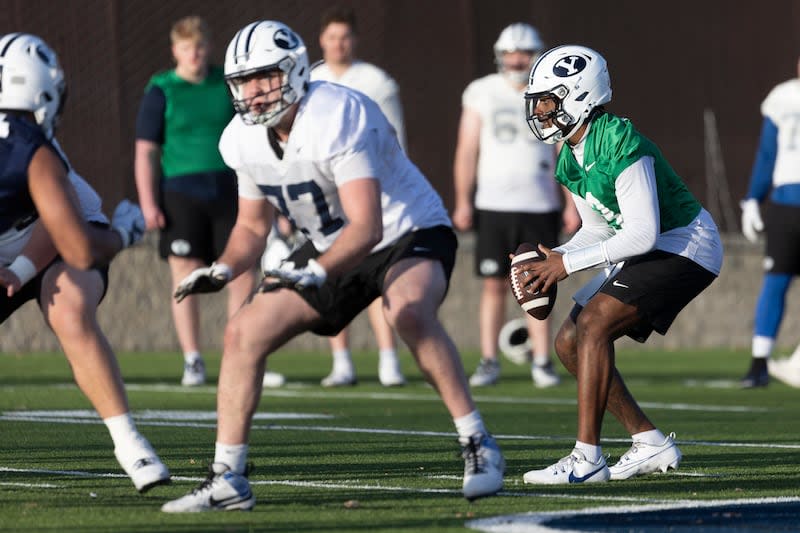
As was reported last week by the Deseret News, Roderick said the starting quarterback derby in 2024 spring practices will be waged between Retzlaff and transfer portal addition Gerry Bohanon, who has played at Baylor and South Florida.
Bohanon has more playing experience, but hasn’t taken a snap since the 2022 season. Retzlaff provides the continuity and familiarity with teammates that Roderick desires, but was not all that impressive in his four starts in 2023, as the Cougars lost all four games and his glaring mistake against Oklahoma — throwing a pick-six in the second half — probably cost BYU a chance for a massive upset.
“It wasn’t a situation where we were going to just sign somebody from the portal no matter what,” Roderick said. “Before Gerry went to South Florida we tried to get him to come and be Jaren Hall’s backup, but he decided on South Florida because he was going to be the starter right away.”
Roderick said he isn’t sure whether offensive analyst Matt Mitchell first contacted Bohanon this time around, or if Bohanon contacted BYU. What he does know is that nothing was promised to the sixth-year senior.
Sitake said he would like to name a starter “as soon as we can,” but acknowledged it could drag on into August.
“The competition is all depending upon who steps out, who does the most to get the spot,” Sitake said. “It is not going to be handed to them. So somebody has to earn it.”
Another possibility to consider: If Retzlaff doesn’t retain the starting job, will he hit the transfer portal?
That’s why a lot of people associated with the program doubt that a starter will be named before preseason training camp begins in August.
Bohanon met with reporters last week and said he wants the starting position “very badly” and is “happy” that Roderick has said he’s got a legitimate shot at it.
“We train for this our entire lives. As a kid, growing up, you want to be a college quarterback and make it to be an NFL quarterback,” Bohanon said. “It is just about the small goals and doing them to get you there. Everybody wants to be in this position. We gotta be good and comfortable with everything that comes with it, for the good and the bad.”
‘One of best two-minute drives’
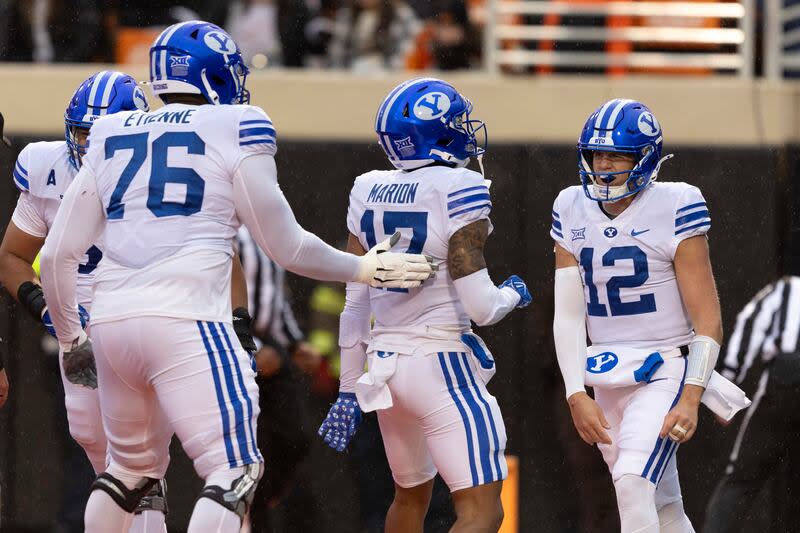
Can Retzlaff run it back, as it were, and win back the starting job? The rising senior with a year of eligibility remaining after this year, if he wants it, said all the right things last Friday when he met with reporters for the first time since immediately after the loss at Oklahoma State.
“To be honest with you, I am not worried about that right now,” he said, when asked if he has the “inside track” to the spot. “I am just worried about going out there and balling. I have been waiting for this for a long time, so worrying about stuff like that that is (not important). It is going to take care of itself. At the end of the day, it is not what I am focused on. I am focused on getting reps and getting out there with the guys. It is fun to play football again.”
Retzlaff brought an element to BYU’s offense last year in four games that Slovis didn’t show in his eight games: the ability to run for positive yardage and pick up first downs with his legs.
He posted a pass efficiency rating of 97.1, however, compared to 122.1 for Slovis (against easier competition, for the most part). BYU’s team passing efficiency was 117.4, ranking 110th nationally.
Looking back at Retzlaff’s performances, Roderick said he played reasonably well against West Virginia, had a setback against Iowa State, and then had two solid outings to finish the season against OU and OSU. The pick-six vs. the Sooners was obviously the low point; the two-minute drive for a field goal to force overtime against OSU was the high point.
“That was one of the best two-minute drives I have been a part of, ever. We were backed up deep, we had to get to field goal range. That was a miserable situation, trying to throw the ball in. That was a really great drive. He made some great throws. He showed a lot of courage and guts.”
BYU offensive coordinator Aaron Roderick
“That was one of the best two-minute drives I have been a part of, ever. We were backed up deep, we had to get to field goal range. That was a miserable situation, trying to throw the ball in. That was a really great drive. He made some great throws. He showed a lot of courage and guts,” Roderick said.
“Again, we didn’t win the game, but he played well. He has proven that he can move the team and score points. The question is, can we coach those critical errors out of him?”
Retzlaff completed 50.4% of his passes for 648 yards and three touchdowns, with three interceptions. He finished as BYU’s third-leading rusher behind Martin and Robbins, picking up 207 yards on the ground, for three touchdowns. He lost 91 rushing yards on sacks.
“He does make plays, and he can throw it. He’s a good athlete. He’s a good runner. He is an exciting player,” Roderick said. “Now the next step is eliminating those one or two critical errors that can cost you a game. … If he can string together a full season of plays like he made at the end, we have a chance to be good.”
